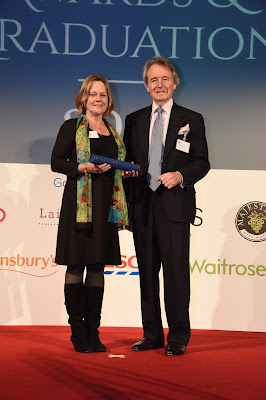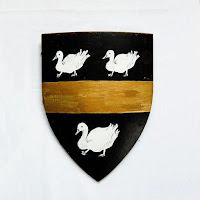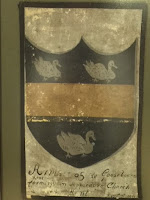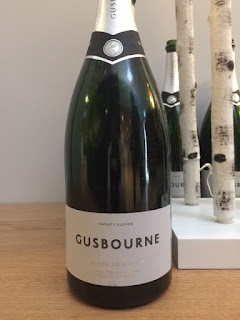Double-decker buses, pubs, royalty, theatre, Downton Abbey — these are the things most of us associate with the British Isles, but how many would think about English wine? Not many, I’m sure, but this island off the northwest coast of Europe, which falls just north of the 50th parallel — long considered the northern boundary for successfully ripening wine grapes — is a rising star in the wine world, producing both red and white still wine and increasingly sparkling wine.
 |
| Receiving my WSET Diploma from Steven Spurrier |
I visited the U.K. in January 2018 to attend my WSET Diploma graduation at Guildhall, London. The ceremony was emotional and affirming for me and my fellow graduates, having studied countless hours and blind-tasted hundreds of wines in order to pass our final exam last June. But we did not taste one English wine in all those years of studying!
So, while in the UK, my fellow traveler and Diploma recipient Melanie and I, and my husband, took advantage of the opportunity to experience a couple of wineries in County Kent, which we reached via a half-hour fast-train ride out of St. Pancras station, London. Sitting just south and southeast of London, Kent and Sussex counties now boast approximately 450 wineries, and the number is growing. Production among all producers is 4.5-5 million bottles per year.
Both counties sit on soil that is not that different from the soils in the Champagne and Burgundy regions of France. This chalky soil with clay and sand subsoils is suitable for growing the same grapes as in Champagne and Burgundy — Chardonnay (the most planted grape in the UK), Pinot Noir (second most planted), and Pinot Meunier (fourth) — as well as many hybrids like Bacchus (third), Seyval Blanc (fifth) and Rondo (seventh). The UK climate is rather cool but grape ripening has been coaxed along the last few summers by warmer-than-usual temperatures which are attributed to global climate change. As an added safety, vineyards in the U.K. are planted on south-facing slopes to make the most of the warming sun during the day.
Two-thirds of the U.K.’s annual production is now sparkling wine produced in the traditional, or bottle-fermented method, as in Champagne.
The two wineries we visited are the small Gusbourne estate and the larger and more widely known Chapel Down. Following is a little more about Gusbourne; my follow-on post will focus on Chapel Down.
Gusbourne Estate: Artisan-Made Vintage Sparkling Wines
 |
| Gusbourne’s current coat of arms |
As an estate, Gusbourne, in Appledore, Kent, dates back to 1410, when John de Goosbourne purchased it, hence the geese on the original coat of arms (see below). The estate (we would call it a farm) grew apples, turnips, mace, and other crops. Upon Goosbourne’s death, Philip Chute, a wealthy man with high social standing in the era of King Henry VIII, purchased the estate and had the coat of arms augmented with the “Lion of England” in recognition of his service to the crown in the Siege of Boulogne.
 |
| Goosbourne’s coat of arms |
Current owner Andrew Weeber hails from South Africa. He purchased the estate in 2003, and planted the first wine grapes in 2004. He had a clear vision to create world-class English sparkling wine, and his first attempt, Gusbourne Sparkling Brut Reserve 2006, debuted in 2010 to critical acclaim.
The current Gusbourne Estate has about 90 acres of vines in Kent and another 50 in Sussex. All grapes used for winemaking at Gusbourne are estate-grown. The three classic Champagne grapes are grown, and there’s a 50-50 split between Champagne and Burgundian clones. The latter produce lower-yielding, but flavorful grapes, per the winery. Vineyard acreage is 60% Pinot Noir, 30% Chardonnay, and 10% Pinot Meunier.
Gusbourne’s vineyards are situated in Kent, which is the second driest place in the U.K., and there are a series of microclimates within the vineyard sites. A really unique landscape feature is an ancient burial mound that sits amidst vineyards adjacent to the winery building, which is a simple, industrial-looking, and very clean and modern facility. The soils are chalky topsoil with clay and sand about 10 meters down, which is particularly good for the Burgundian clones.
 |
| An ancient burial mound sits in vineyard land of Gusbourne Estate |
 |
| Our wardrobe gives an idea of how cold U.K. vineyards can get in the middle of January. |
 |
| Fellow WSET Diploma graduate Melanie Webber and I enjoying wines at The Nest at Gusbourne |
 |
| Dan, our excellent and knowledgeable tour and tasting guide at Gusbourne |
The winery operations are quite modern and well-equipped with the latest technology, including a gyropalette that can rotate hundreds of bottles of sparkling wine by machine, to bring the yeast into the neck of the bottle for eventually disgorgement (see photo below).
 |
| Gusbourne’s gyropalette rotates hundreds of bottles at a time |
Gusbourne produces between 100,00 and 200,000 bottles per year, depending on vintage, of which 95% is sparkling. English weather can be very wet, as was 2012, so producers are often at the mercy of the seasons, but this is true of most Old World wine regions.
 |
| Gusbourne’s flagship Blanc de Blanc |
The day we were visiting, the winds were sweeping across the fields, but it was a beautiful landscape, with neatly groomed and well tended vines, and the coastline visible about six miles away. (Keep in mind that you are rarely more than 70 miles away from any coastline in the U.K.) This portion of the English coast was under water until about 800 hundred years ago, but the sea receded over time.
Gusbourne’s flagship product is its Blanc de Blanc sparkling (photo left), which is aged 36 months on the lees and then another three months on cork after disgorgement. The wine is lovely, with notes of green apple, cirtus and white fruit, mineral notes, and buttered toast from lees aging, and the crisp acidity that is the hallmark of English sparkling. This wine retails in the U.S. at around $65 (45 pounds).
In addition to vintage sparkling, Gusbourne also produces still wines, including Pinot Noir and Chardonnay, which are light-bodied and very tasty.
For more information on Gusbourne and its wines, visit www.Gusbourne.com.
For availability of Gusbourne wines locally, check www.winesearcher.com.
For more information on the English wine industry, visit www.englishwineproducers.co.uk/.
And to learn more about the WSET program, visit www.wsetglobal.com.
Until next time,
Cheers!
